Modeling the Blood-Brain Barrier Permeability of Potential Heterocyclic Drugs via Biomimetic IAM Chromatography Technique Combined with QSAR Methodology
Abstract
1. Introduction
2. Results and Discussion
2.1. In Silico Characteristics
2.2. Establishment of Quantitative Structure (Retention)–Activity Relationships
2.3. Assessing the Molecular Targets for Potential Pharmaceuticals Evaluated in This Paper (1–126)
3. Materials and Methods
3.1. Solvents and Reagents
3.2. Chromatography Equipment
3.3. Chromatographic Conditions
3.4. In Silico Studies
3.5. Statistical Analysis
4. Conclusions
Supplementary Materials
Author Contributions
Funding
Institutional Review Board Statement
Informed Consent Statement
Data Availability Statement
Conflicts of Interest
References
- Chackalamannil, S.; Rotella, D.; Ward, S.E. (Eds.) Comprehensive Medicinal Chemistry III; Elsevier: Amsterdam, The Netherlands, 2017; ISBN 978-0-12-803201-5. [Google Scholar]
- Valko, K.L.; Rava, S.; Bunally, S.; Anderson, S. Revisiting the application of Immobilized Artificial Membrane (IAM) chromatography to estimate in vivo distribution properties of drug discovery compounds based on the model of marketed drugs. ADMET DMPK 2020, 8, 78–97. [Google Scholar] [CrossRef] [PubMed]
- Barbato, F.; di Martino, G.; Grumetto, L.; La Rotonda, M.I. Prediction of drug-membrane interactions by IAM-HPLC: Effects of different phospholipid stationary phases on the partition of bases. Eur. J. Pharm. Sci. 2004, 2, 261–269. [Google Scholar] [CrossRef] [PubMed]
- Jiang, Z.; Reilly, J. Chromatography approaches for early screening of the phospholipidosis-inducing potential of pharmaceuticals. J. Pharm. Biomed. Anal. 2012, 6, 184–190. [Google Scholar] [CrossRef]
- Valko, K.; Teague, S.; Pidgeon, C. In vitro membrane binding and protein binding (IAM MB/PB technology) to estimate in vivo distribution: Applications in early drug discovery. ADMET DMPK 2017, 5, 14–38. [Google Scholar] [CrossRef]
- Tsopelas, F.; Giaginis, C.; Tsantili-Kakoulidou, A. Lipophilicity and biomimetic properties to support drug discovery. Expert Opin. Drug Discov. 2017, 12, 885–896. [Google Scholar] [CrossRef] [PubMed]
- Tsopelas, F.; Vallianatou, T.; Tsantili-Kakoulidou, A. Advances in immobilized artificial membrane (IAM) chromatography for novel drug discovery. Expert Opin. Drug Discov. 2016, 11, 473–478. [Google Scholar] [CrossRef] [PubMed]
- Bunally, S.; Young, R.J. The role and impact of high throughput biomimetic measurements in drug discovery. ADMET DMPK 2018, 6, 74–84. [Google Scholar] [CrossRef]
- Sobańska, A.W.; Brzezińska, E. Phospholipid-based immobilized artificial membrane (IAM) chromatography: A powerful tool to model drug distribution processes. Curr. Pharm. Design 2017, 44, 6784–6794. [Google Scholar] [CrossRef]
- Grumetto, L.; Russo, G.; Barbato, F. Immobilized Artificial Membrane HPLC Derived Parameters vs. PAMPA-BBB Data in Estimating in Situ Measured Blood-Brain Barrier Permeation of Drugs. Mol. Pharm. 2016, 13, 2808–2816. [Google Scholar] [CrossRef]
- Hollósy, F.; Valkó, K.L.; Hersey, A.; Nunhuck, S.; Kéri, G.; Bevan, C. Estimation of volume of distribution in humans from high throughput HPLC-based measurements of human serum albumin binding and immobilized artificial membrane partitioning. J. Med. Chem. 2006, 49, 6958–6971. [Google Scholar] [CrossRef]
- Valkó, K.L. Physicochemical and Biomimetic Properties in Drug Discovery: Chromatographic Techniques for Lead Optimization; Wiley: Hoboken, NJ, USA, 2014. [Google Scholar]
- Valkó, K.L.; Nunhuck, S.; Bevan, C.; Abraham, M.H.; Reynolds, D.P. Fast gradient HPLC method to determine compounds binding to human serum albumin. Relationships with octanol/water and immobilized artificial membrane lipophilicity. J. Pharm. Sci. 2003, 9, 2236–2248. [Google Scholar] [CrossRef] [PubMed]
- De Vrieze, M.; Verzele, D.; Szucs, R.; Sandra, P.; Lynen, F. Evaluation of sphingomyelin, cholester, and phosphatidylcholine-based immobilized artificial membrane liquid chromatography to predict drug penetration across the blood-brain barrier. Anal. Bioanal. Chem. 2014, 406, 6179–6188. [Google Scholar] [CrossRef] [PubMed]
- Kerns, H.; Li, D.; Dunkel, N.W. (Eds.) Blood-Brain Barrier in Drug Discovery: Optimizing Brain Exposure of CNS Drugs and Minimizing Brain Side Effects for Peripheral Drugs; Wiley: Hoboken, NJ, USA, 2015. [Google Scholar]
- Andersen, P.H.; Moscicki, R.; Sahakian, B.; Quirion, R.; Krishnan, R.; Race, T.; Phillips, A. Securing the future of drug discovery for central nervous system disorders. Nat. Rev. Drug Discov. 2014, 13, 871–872. [Google Scholar] [PubMed]
- Bickel, U. How to measure drug transport across the blood brain barrier. NeuroRX 2005, 2, 15–26. [Google Scholar] [CrossRef] [PubMed]
- Lipinski, C.A.; Lombardo, F.; Dominy, B.W.; Feeney, P.J. Experimental and computational approaches to estimate solubility and permeability in drug discovery and development settings. Adv. Drug Deliv. Rev. 1997, 23, 3–25. [Google Scholar] [CrossRef]
- Clark, D.E. In silico prediction of blood–brain barrier permeation. Drug Discov. Today 2003, 15, 927–933. [Google Scholar] [CrossRef] [PubMed]
- van de Waterbeemd, H.; Camenish, G.; Folkers, G.; Chretien, J.R.; Raevsky, O.A. Estimation of blood-brain barrier crossing of drugs using molecular size and shape, and H-bonding descriptors. J. Drugs Target. 1998, 6, 151–165. [Google Scholar] [CrossRef] [PubMed]
- Janicka, M.; Sztanke, M.; Sztanke, K. Reversed-phase liquid chromatography with octadecylsilyl, immobilized artificial membrane and cholesterol columns in correlation studies with in silico biological descriptors of newly synthesized antiproliferative and analgesic active compounds. J. Chromatogr. A 2013, 1318, 92–101. [Google Scholar] [CrossRef]
- Janicka, M.; Mycka, A.; Sztanke, M.; Sztanke, K. Predicting Pharmacokinetic Properties of Potential Anticancer Agents via Their Chromatographic Behavior on Different Reversed Phase Materials. Int. J. Mol. Sci. 2021, 22, 4257. [Google Scholar] [CrossRef]
- Janicka, M.; Sztanke, M.; Sztanke, K. Predicting the blood–brain barrier permeability of new drug–like compounds via HPLC with various stationary phases. Molecules 2020, 25, 487. [Google Scholar] [CrossRef] [PubMed]
- Ghose, A.K.; Viswanadhan, V.N.; Wendoloski, J.J. A knowledge-based approach in designing combinatorial or medicinal chemistry libraries for drug discovery. 1. A qualitative and quantitative characterization of known drug databases. J. Comb. Chem. 1999, 1, 55–68. [Google Scholar] [CrossRef] [PubMed]
- Kelder, J.; Grootenhuis, P.D.; Bayada, D.M.; Delbressine, L.P.; Ploemen, J.P. Polar molecular surface as dominating determinant for oral absorption and brain penetration of drugs. Pharm. Res. 1999, 16, 1514–1519. [Google Scholar] [CrossRef] [PubMed]
- Kralj, S.; Jukič, M.; Bren, U. Molecular filters in medicinal chemistry. Encyclopedia 2023, 3, 501–511. [Google Scholar] [CrossRef]
- van de Waterbeemd, H.; Smith, D.A.; Beaumont, K.; Walker, D.K. Property-based design: Optimization of drug absorption and pharmacokinetics. J. Med. Chem. 2001, 44, 1313–1333. [Google Scholar] [CrossRef] [PubMed]
- Ajay; Bemis, G.W.; Murcko, M.A. Designing libraries with CNS activity. J. Med. Chem. 1999, 42, 4942–4951. [Google Scholar] [CrossRef] [PubMed]
- Hou, T.; Xu, X. ADME evaluation in drug discovery 1. Applications of genetic algorithms to the prediction of blood–brain partitioning of a large set of drugs. J. Mol. Model. 2002, 8, 337–349. [Google Scholar] [CrossRef]
- Hansch, C. Quantitative Structure-Activity Relationships and the Unnamed Science. Acc. Chem. Res. 1993, 26, 147–153. [Google Scholar] [CrossRef]
- Héberger, K. Quantitative structure-(chromatographic) retention relationships. J. Chromatogr. A 2007, 1158, 273–305. [Google Scholar] [CrossRef]
- Kaliszan, R. Quantitative Structure-Chromatographic Retention Relationships; Winefordner, J.D., Ed.; John Wiley & Sons: Hoboken, NJ, USA, 1987. [Google Scholar]
- Grassy, G.; Chavanieu, A. Molecular Lipophilicity: A Predominant Descriptor for QSAR. In Chemogenomics and Chemical Genetics; Marechal, E., Roy, S., Lafanechère, L., Eds.; Springer: Berlin/Heidelberg, Germany, 2011. [Google Scholar]
- Breyer, E.D.; Strasters, J.K.; Khaledi, M.G. Quantitative Retention-Biological Activity Relationship Study by Micellar Liquid Chromatography. Anal. Chem. 1991, 63, 828–833. [Google Scholar] [CrossRef]
- Quiñones-Torrelo, C.; Sagrado-Vives, S.; Villanueva-Camañas, R.M.; Medina-Hernández, M.J. An LD50 model for predicting psychotropic drug toxicity using biopartitioning micellar chromatography. Biomed. Chromatogr. 2001, 15, 31–40. [Google Scholar] [CrossRef]
- Eriksson, L.; Jaworska, J.; Worth, A.P.; Cronin, M.T.; McDowell, R.M.; Gramatica, P. Methods for reliability and uncertainty assessment and for applicability evaluations of classification- and regression-based QSARs. Environ. Health Perspect. 2003, 111, 1361–1375. [Google Scholar] [CrossRef] [PubMed]
- Liu, R.; Sun, H.; So, S.S. Development of Quantitative Structure–Property Relationship Models for Early ADME Evaluation in Drug Discovery. 2. Blood-Brain Barrier Penetration. J. Chem. Inf. Comp. Sci. 2001, 41, 1623–1632. [Google Scholar] [CrossRef] [PubMed]
- Pourbasheer, E.; Riahi, S.; Ganjali, M.R.; Norouzi, P. Quantitative structure-activity relationship (QSAR) study of interleukin-1 receptor associated kinase 4 (IRAK-4) inhibitor activity by the genetic algorithm and multiple linear regression (GA-MLR) method. J. Enzyme Inhib. Med. Chem. 2010, 25, 844–853. [Google Scholar] [CrossRef] [PubMed]
- Abraham, M.H.; Chadha, H.S.; Mitchell, R.C. Hydrogen bonding. 33. Factors that influence the distribution of solutes between blood and brain. J. Pharm. Sci. 1994, 83, 1257–1268. [Google Scholar] [CrossRef] [PubMed]
- Ertl, P.; Rohde, B.; Selzer, P. Fast calculation of molecular polar surface area as a sum of fragment-based contributions and its application to the prediction of drug transport properties. J. Med. Chem. 2000, 43, 3714–3717. [Google Scholar] [CrossRef] [PubMed]
- Cartier, A.; Rivail, J.L. Electronic descriptors in quantitative structure–activity relationships. Chemom. Intell. Lab. Syst. 1987, 1, 335–347. [Google Scholar] [CrossRef]
- Farmarzi, S.; Kim, M.T.; Volpe, D.A.; Cross, K.P.; Chakravarti, S.; Stavitskaya, L. Development of QSAR models to predict blood-brain barrier permeability. Front. Pharmacol. 2022, 13, 1040838. [Google Scholar] [CrossRef]
- Valkó, K.L. Lipophilicity and biomimetic properties measured by HPLC to support drug discovery. J. Pharm. Biomed. Anal. 2016, 130, 35–54. [Google Scholar] [CrossRef]
- Organization for Economic Co-Operation and Development. Guidance Document on the Validation of (Quantitative) Structure-Activity Relationship [(Q)SAR] Models; OECD Series on Testing and Assessment, No. 69; OECD Publishing: Paris, France, 2014. [Google Scholar] [CrossRef]
- Gramatica, P. On the development and validation of QSAR models. In Computational Toxicology. Methods in Molecular Biology; Reisfeld, B., Mayeno, A., Eds.; Humana Press: Totowa, NJ, USA, 2013. [Google Scholar]
- Frost, J. Regression Analysis: An Intuitive Guide for Using and Interpreting Linear Models; Statistics By Jim Publishing: Columbia, MD, USA, 2020. [Google Scholar]
- Abdullahi, M.; Uzairu, A.; Shallangwa, G.A.; Mamza, P.A.; Ibrahim, M.T. In-silico modelling studies of 5-benzyl-4-thiazolinone derivatives as influenza neuraminidase inhibitors via 2D-QSAR, 3D-QSAR, molecular docking, and ADMET predictions. Heliyon 2022, 8, e10101. [Google Scholar] [CrossRef]
- Roy, K.; Kar, S.; Ambure, P. On a simple approach for determining applicability domain of QSAR models. Chemom. Intell. Lab. Syst. 2015, 145, 22–29. [Google Scholar] [CrossRef]
- Sahigara, F.; Mansouri, K.; Ballabio, D.; Mauri, A.; Consonni, V.; Todeschini, R. Comparison of different approaches to define the applicability domain of QSAR models. Molecules 2012, 17, 4791–4810. [Google Scholar] [CrossRef] [PubMed]
- Abdi, H.A.; Williams, L.J. Principal Component Analysis; John Willey & Sons: Hoboken, NJ, USA, 2010; Volume 2, pp. 433–459. [Google Scholar]
- Hamadache, M.; Benkortbi, O.; Hanini, S.; Amrane, A. QSAR modeling in ecotoxicological risk assessment: Application to the prediction of acute contact toxicity of pesticides on bees (Apis mellifera L.). Environ. Sci. Pollut. Res. 2018, 25, 896–907. [Google Scholar] [CrossRef] [PubMed]
- Hamadache, M.; Benkortbi, O.; Hanini, H.; Amrane, A.; Khaouane, L.; Si Moussa, C. A quantitative structure activity relationship for acute oral toxicity of pesticides on rats: Validation, domain of application and prediction. J. Hazard. Mater. 2016, 303, 28–40. [Google Scholar] [CrossRef] [PubMed]
- Sawant, S.D.; Nerkar, A.G.; Pawar, N.D.; Velapure, A.V. Design, synthesis, QSAR studies and biological evaluation of novel triazolopiperazine based β-amino amides as dipeptidyl peptidase-IV (DPP-IV) inhibitors: Part-II. Int. J. Pharm. Pharm. Sci. 2014, 6, 812–817. [Google Scholar]
- Clementi, M.; Clementi, S.; Fornaciari, M.; Orlandi, F.; Romano, B. The GOLPE procedure for predicting olive crop production from climatic parameters. J. Chemom. 2001, 15, 397–404. [Google Scholar] [CrossRef]
- Chen, J.W.; Li, X.H.; Yu, H.Y.; Wang, Y.N.; Qiao, X.L. Progress and perspectives of quantitative structure–activity relationships used for ecological risk assessment of toxic organic compounds. Sci. China Ser. B-Chem. 2008, 51, 593–606. [Google Scholar] [CrossRef]
- Saaidpour, S.; Bahmani, A.; Rostami, A. Prediction the normal boiling points of primary, secondary and tertiary liquid amines from their molecular structure descriptors. CMST 2015, 21, 201–210. [Google Scholar] [CrossRef]
- Norinder, U.; Osterberg, T. The applicability of computational chemistry in the evaluation and prediction of drug transport properties. Perspect. Drug Discov. Des. 2000, 19, 1–18. [Google Scholar] [CrossRef]
- Abbott, N.J. Prediction of blood–brain permeation in drug discovery from in vivo, in vitro and in silico models. Drug Discov. Today Technol. 2004, 1, 407–416. [Google Scholar] [CrossRef]
- Abraham, M.H.; Ibrahim, A.; Zissimos, A.M.; Zhao, Y.H.; Zhao, Y.H.; Comer, J.; Reynolds, D.P. Application of hydrogen bonding calculations in property based drug design. Drug Discov. Today 2002, 7, 1056–1063. [Google Scholar] [CrossRef]
- Abraham, M.H.; Gola, J.M.R.; Kumarsingh, R.; Cometto-Muniz, J.E.; Cain, W.S. Connection between chromatograhphic data and biological data. J. Chromatogr. B 2000, 745, 103–115. [Google Scholar] [CrossRef]
- Abraham, M.H.; Chadha, H.S.; Mitchell, R.C. The Factors that Influence Skin Penetration of Solutes. J. Pharm. Pharmacol. 2011, 47, 8–16. [Google Scholar] [CrossRef]
- Gratton, J.A.; Abraham, M.H.; Bradbury, M.W.; Chadcha, H.S. Molecular factors influencing drug transfer across the blood–brain barrier. J. Pharm. Pharmacol. 1997, 49, 1211–1216. [Google Scholar] [CrossRef]
- Ware, J.A. Membrane Transporters in Drug Discovery and Development: A New Mechanistic ADME Era. Mol. Pharm. 2006, 3, 1–2. [Google Scholar] [CrossRef] [PubMed][Green Version]
- Clark, D.E. Rapid calculation of polar molecular surface area and its application to the prediction of transport phenomena. 2. Prediction of blood-brain barrier penetration. J. Pharm. Sci. 1999, 88, 815–821. [Google Scholar] [CrossRef] [PubMed]
- Abraham, M.H.; Takács-Novák, K.; Mitchell, R.C. On the partition of ampholytes: Application to blood-brain distribution. J. Pharm. Sci. 1997, 86, 310–315. [Google Scholar] [CrossRef] [PubMed]
- Vilar, S.; Chakrabarti, M.; Costanzi, S. Prediction of passive blood-brain partitioning: Straightforward and effective classification models based on in silico derived physicochemical descriptors. J. Mol. Graph. Model. 2010, 28, 899–903. [Google Scholar] [CrossRef]
- Aggarwal, R.; Sumran, G. An insight on medicinal attributes of 1,2,4-triazoles. Eur. J. Med. Chem. 2020, 205, 112692. [Google Scholar] [CrossRef]
- Urich, R.; Wishart, G.; Kiczun, M.; Richters, A.; Tidten-Luksch, N.; Rauh, D.; Sherborne, B.; Wyatt, P.G.; Brenk, R. De novo design of protein kinase inhibitors by in silico identification of hinge region-binding fragments. ACS Chem. Biol. 2013, 8, 1044–1052. [Google Scholar] [CrossRef]
- Balewski, Ł.; Sączewski, F.; Bednarski, P.J.; Wolff, L.; Nadworska, A.; Gdaniec, M.; Kornicka, A. Synthesis, structure and cytotoxicity testing of novel 7-(4,5-dihydro-1H-imidazol-2-yl)-2-aryl-6,7-dihydro-2H-imidazo[2,1-c][1,2,4]triazol-3(5H)-imine derivatives. Molecules 2020, 25, 5924. [Google Scholar] [CrossRef]
- Taliani, S.; Pugliesi, I.; Barresi, E.; Simorini, F.; Salerno, S.; La Motta, C.; Marini, A.M.; Cosimelli, B.; Cosconati, S.; Di Maro, S.; et al. 3-Aryl-[1,2,4]triazino[4,3-a]benzimidazol-4(10H)-one: A novel template for the design of highly selective A2B adenosine receptor antagonists. J. Med. Chem. 2012, 55, 1490–1499. [Google Scholar] [CrossRef] [PubMed]
- Aapro, M.S. Innovative Metabolites in Solid Tumours; Springer: Berlin/Heidelberg, Germany, 1994. [Google Scholar]
- Tzvetkov, N.T.; Euler, H.; Müller, C.E. Regioselective synthesis of 7,8-dihydroimidazo[5,1-c][1,2,4]triazine-3,6(2H,4H)-dione derivatives: A new drug-like heterocyclic scaffold. Beilstein J. Org. Chem. 2012, 8, 1584–1593. [Google Scholar] [CrossRef] [PubMed]
- Soczewiński, E.; Wachtmeister, C.A. The relation between the composition of certain ternary two-phase solvent systems and RM values. J. Chromatogr. 1962, 7, 311–320. [Google Scholar] [CrossRef]
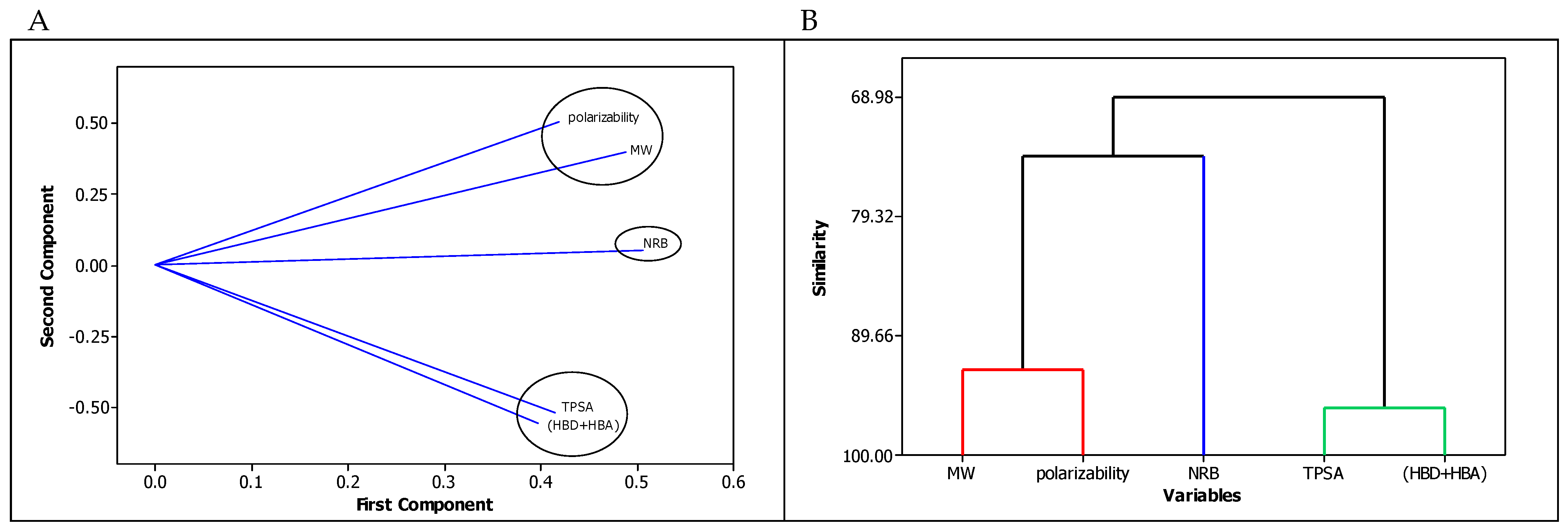
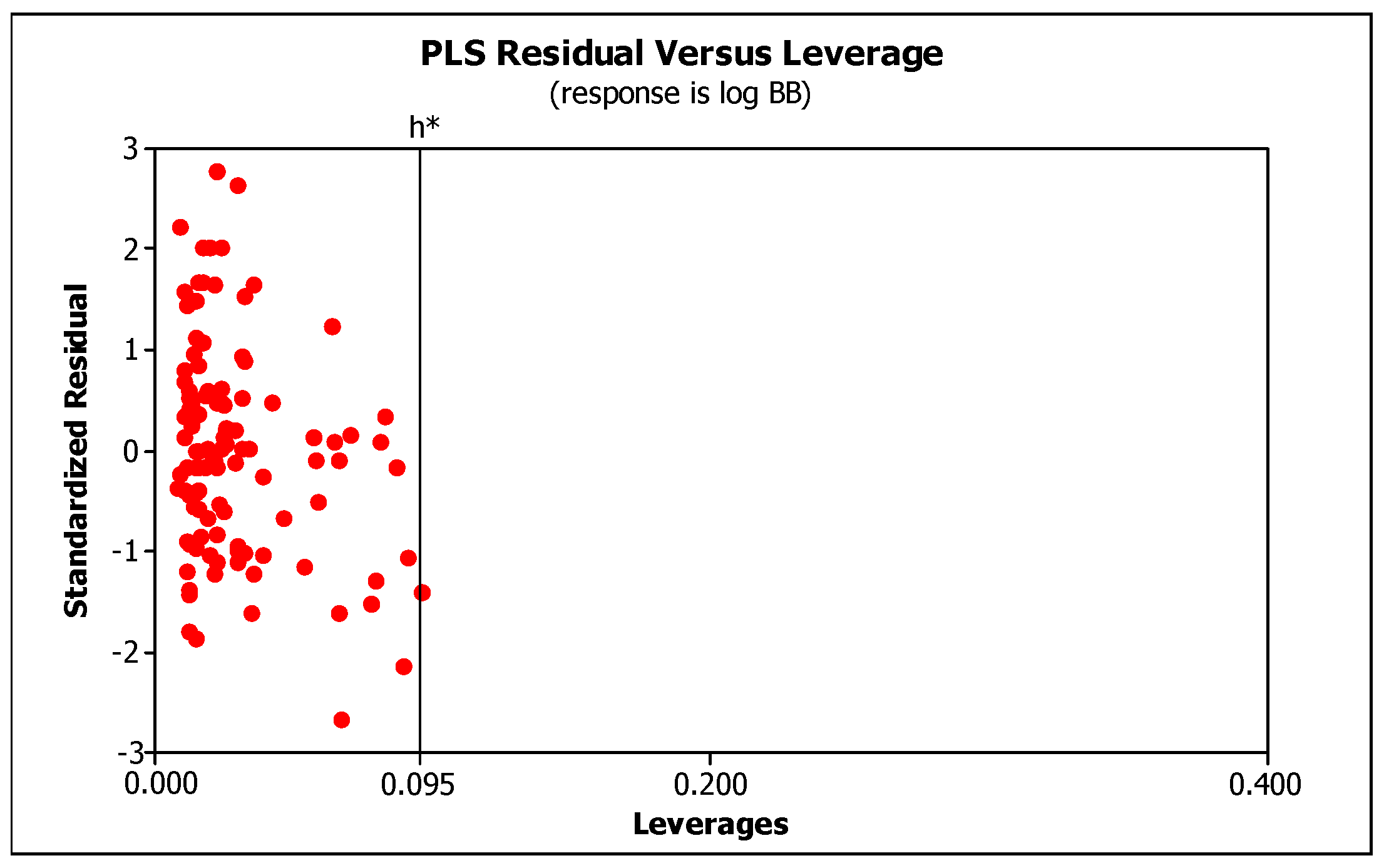
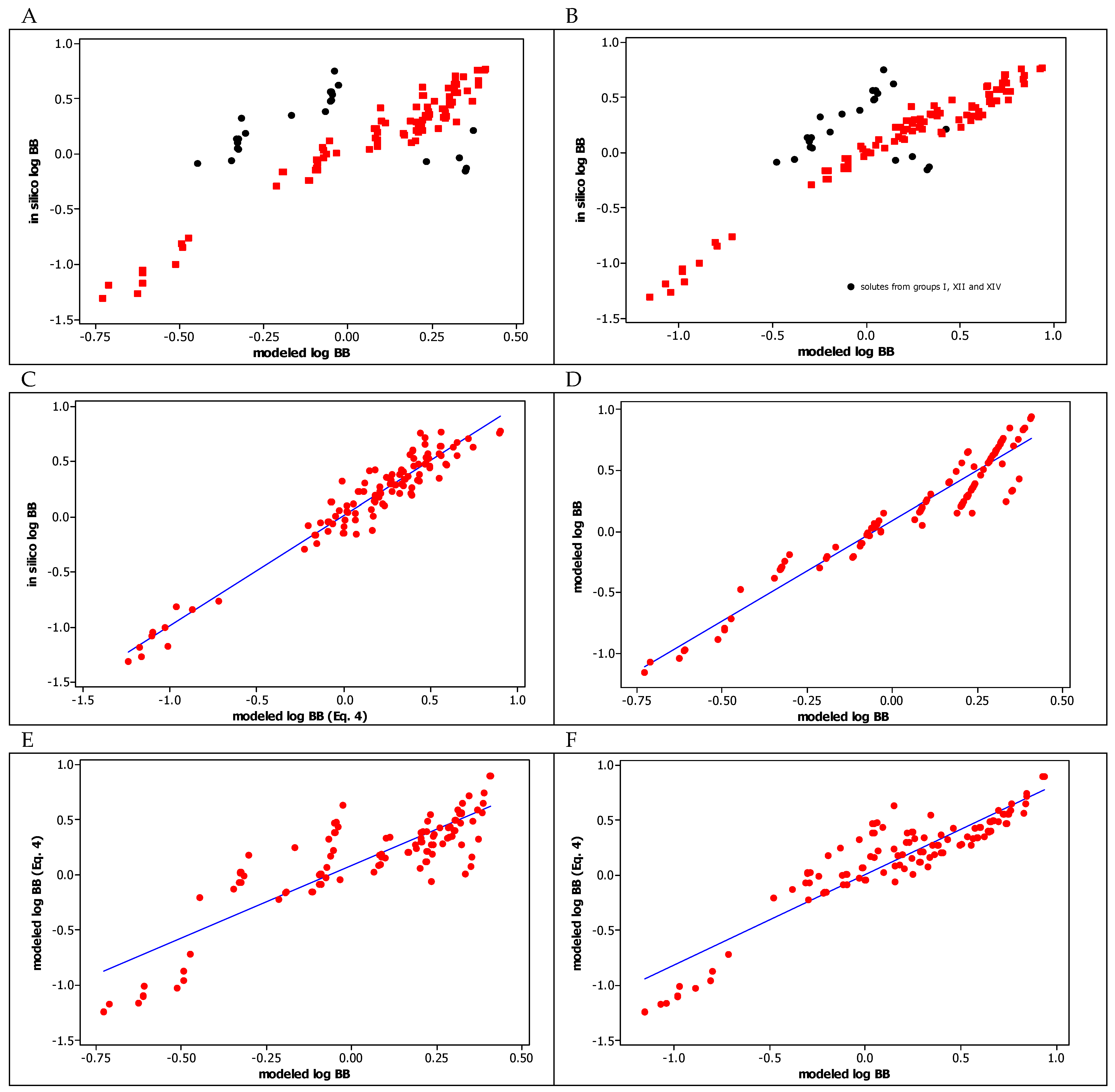
| Class | General Structure | No. | R1 | R2 |
|---|---|---|---|---|
| I |  | 1 2 3 4 5 | R1 = H R1 = 4-CH3 R1 = 4-OCH3 R1 = 3-Cl R1 = 3,4-Cl2 | |
| II | 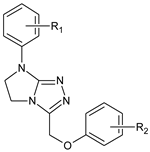 | 6 7 8 9 10 11 12 13 14 | R1 = H R1 = 4-OCH3 R1 = H R1 = 4-CH3 R1 = 4-Cl R1 = 4-Cl R1 = 4-Cl R1 = 3,4-Cl2 R1 = 4-Cl | R2 = H R2 = 4-Cl R2 = 2-CH3; 4-Cl R2 = 2-CH3; 4-Cl R2 = 4-Cl R2 = 2-CH3; 4-Cl R2 = 2,4-Cl2 R2 = 2,4-Cl2 R2 = 2,4,5-Cl3 |
| III | 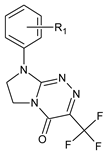 | 15 16 17 18 19 20 21 22 | R1 = H R1 = 2-CH3 R1 = 4-CH3 R1 = 2-OCH3 R1 = 2-Cl R1 = 3-Cl R1 = 4-Cl R1 = 3,4-Cl2 | |
| IV |  | 23 24 25 26 27 28 | R1 = H R1 = 4-CH3 R1 = 2-Cl R1 = 3-Cl R1 = 4-Cl R1 = 3,4-Cl2 | |
| V | 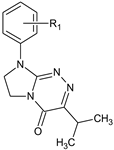 | 29 30 31 32 33 34 | R1 = H R1 = 4-CH3 R1 = 2-Cl R1 = 3-Cl R1 = 4-Cl R1 = 3,4-Cl2 | |
| VI | 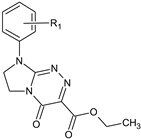 | 35 36 37 38 39 | R1 = H R1 = 4-CH3 R1 = 3-Cl R1 = 4-Cl R1 = 3,4-Cl2 | |
| VII | 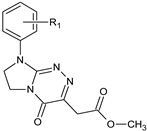 | 40 41 42 43 44 | R1 = H R1 = 4-CH3 R1 = 4-OCH3 R1 = 4-OC2H5 R1 = 4-Cl | |
| VIII |  | 45 46 47 48 49 50 | R1 = H R1 = 4-CH3 R1 = 2-OCH3 R1 = 3-Cl R1 = 4-Cl R1 = 3,4-Cl2 | |
| IX | 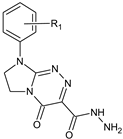 | 51 52 53 54 55 | R1 = H R1 = 4-CH3 R1 = 4-OCH3 R1 = 3-Cl R1 = 3,4-Cl2 | |
| X | 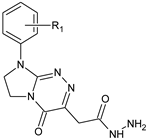 | 56 57 58 59 60 | R1 = H R1 = 4-CH3 R1 = 4-OCH3 R1 = 4-OC2H5 R1 = 4-Cl | |
| XI | 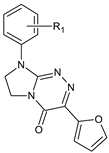 | 61 62 63 64 65 66 67 68 69 70 71 | R1 = H R1 = 2-CH3 R1 = 4-CH3 R1 = 2,3-(CH3)2 R1 = 2-OCH3 R1 = 4-OCH3 R1 = 2-Cl R1 = 3-Cl R1 = 4-Cl R1 = 3,4-Cl2 R1 = 2,6-Cl2 | |
| XII | 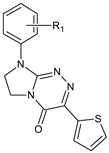 | 72 73 74 75 76 77 78 79 80 | R1 = H R1 = 2-CH3 R1 = 4-CH3 R1 = 2,3-(CH3)2 R1 = 2-OCH3 R1 = 2-Cl R1 = 3-Cl R1 = 4-Cl R1 = 3,4-Cl2 | |
| XIII | 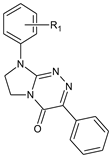 | 81 82 83 84 85 86 87 88 89 90 91 92 | R1 = H R1 = 2-CH3 R1 = 3-CH3 R1 = 4-CH3 R1 = 2-OCH3 R1 = 4-OCH3 R1 = 4-OC2H5 R1 = 2,3-(CH3)2 R1 = 2-Cl R1 = 3-Cl R1 = 4-Cl R1 = 3,4-Cl2 | |
| XIV | 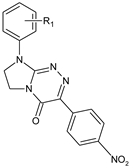 | 93 94 95 96 97 98 99 100 101 | R1 = H R1 = 2-CH3 R1 = 4-CH3 R1 = 2-OCH3 R1 = 2,3-(CH3)2 R1 = 2-Cl R1 = 3-Cl R1 = 4-Cl R1 = 3,4-Cl2 | |
| XV |  | 102 103 104 105 106 107 108 109 110 111 112 113 114 115 116 117 118 119 120 121 | R1 = H R1 = H R1 = H R1 = H R1 = 4-CH3 R1 = 4-CH3 R1 = 4-CH3 R1 = 4-CH3 R1 = 4-CH3 R1 = 4-CH3 R1 = 4-OC2H5 R1 = 4-OC2H5 R1 = 4-OC2H5 R1 = 4-OC2H5 R1 = 4-OC2H5 R1 = 2-CH3 R1 = 4-Cl R1 = 4-Cl R1 = 4-Cl R1 = 4-Cl | R2 = H R2 = 2-Cl R2 = 3-Cl R2 = 4-Cl R2 = H R2 = 4-CH3 R2 = 3-CH3 R2 = 2-Cl R2 = 3-Cl R2 = 4-Cl R2 = H R2 = 4-CH3 R2 = 2-Cl R2 = 3-Cl R2 = 4-Cl R2 = 2-Cl R2 = H R2 = 2-Cl R2 = 3-Cl R2 = 4-Cl |
| XVI | 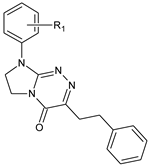 | 122 123 124 125 126 | R1 = H R1 = 4-CH3 R1 = 2-Cl R1 = 4-Cl R1 = 3,4-Cl2 |
| Compound | MW [g mol−1] | NRB | HBD | HBA | TPSA [Å2] | α [Å3] | log BB | log kw, IAM |
|---|---|---|---|---|---|---|---|---|
| 1 | 186.21 | 1 | 0 | 4 | 33.95 | 21.80 | −0.033 | 0.10 |
| 2 | 200.24 | 1 | 0 | 4 | 33.95 | 23.56 | −0.159 | 0.41 |
| 3 | 216.24 | 2 | 0 | 5 | 43.18 | 24.11 | −0.068 | 0.10 |
| 4 | 220.66 | 1 | 0 | 4 | 33.95 | 23.63 | −0.128 | 0.64 |
| 5 | 255.10 | 1 | 0 | 4 | 33.95 | 25.45 | 0.209 | 1.18 |
| 6 | 292.34 | 4 | 0 | 5 | 43.18 | 34.13 | 0.292 | 0.11 |
| 7 | 356.81 | 5 | 0 | 6 | 52.41 | 38.26 | 0.340 | 0.06 |
| 8 | 340.81 | 4 | 0 | 5 | 43.18 | 37.71 | 0.571 | 0.09 |
| 9 | 354.83 | 4 | 0 | 5 | 43.18 | 39.47 | 0.763 | 1.95 |
| 10 | 361.22 | 4 | 0 | 5 | 43.18 | 37.78 | 0.476 | 1.86 |
| 11 | 375.25 | 4 | 0 | 5 | 43.18 | 39.54 | 0.668 | 2.14 |
| 12 | 395.67 | 4 | 0 | 5 | 43.18 | 39.61 | 0.626 | 2.25 |
| 13 | 430.11 | 4 | 0 | 5 | 43.18 | 41.43 | 0.772 | 2.91 |
| 14 | 430.11 | 4 | 0 | 5 | 43.18 | 41.43 | 0.758 | 2.55 |
| 15 a | 282.22 | 2 | 0 | 5 | 48.27 | 25.85 | 0.102 | 0.94 |
| 16 a | 296.25 | 2 | 0 | 5 | 48.27 | 27.61 | 0.290 | 0.76 |
| 17 a | 296.25 | 2 | 0 | 5 | 48.27 | 27.61 | 0.290 | 1.25 |
| 18 a | 312.25 | 3 | 0 | 6 | 57.50 | 28.16 | 0.063 | 0.67 |
| 19 a | 316.67 | 2 | 0 | 5 | 48.27 | 27.68 | 0.211 | 0.88 |
| 20 a | 316.67 | 2 | 0 | 5 | 48.27 | 27.68 | 0.264 | 1.66 |
| 21 a | 316.67 | 2 | 0 | 5 | 48.27 | 27.68 | 0.194 | 1.58 |
| 22 a | 351.11 | 2 | 0 | 5 | 48.27 | 29.50 | 0.345 | 2.29 |
| 23 b | 242.28 | 2 | 0 | 5 | 48.27 | 27.55 | 0.117 | 0.55 |
| 24 b | 256.30 | 2 | 0 | 5 | 48.27 | 29.30 | 0.305 | 1.00 |
| 25 b | 276.72 | 2 | 0 | 5 | 48.27 | 29.37 | 0.226 | 0.80 |
| 26 b | 276.72 | 2 | 0 | 5 | 48.27 | 29.37 | 0.270 | 0.84 |
| 27 b | 276.72 | 2 | 0 | 5 | 48.27 | 29.37 | 0.209 | 1.24 |
| 28 b | 311.17 | 2 | 0 | 5 | 48.27 | 31.20 | 0.360 | 1.85 |
| 29 a | 256.30 | 2 | 0 | 5 | 48.27 | 29.30 | 0.230 | 0.76 |
| 30 a | 270.33 | 2 | 0 | 5 | 48.27 | 31.06 | 0.423 | 1.05 |
| 31 a | 290.75 | 2 | 0 | 5 | 48.27 | 31.13 | 0.339 | 0.65 |
| 32 a | 290.75 | 2 | 0 | 5 | 48.27 | 31.13 | 0.384 | 1.49 |
| 33 a | 290.75 | 2 | 0 | 5 | 48.27 | 31.13 | 0.328 | 1.39 |
| 34 a | 325.19 | 2 | 0 | 5 | 48.27 | 32.95 | 0.473 | 1.67 |
| 35 a | 286.29 | 4 | 0 | 7 | 74.57 | 30.27 | −0.243 | 0.48 |
| 36 a | 300.31 | 4 | 0 | 7 | 74.57 | 32.02 | −0.051 | 1.93 |
| 37 a | 320.73 | 4 | 0 | 7 | 74.57 | 32.09 | −0.090 | 1.73 |
| 38 a | 320.73 | 4 | 0 | 7 | 74.57 | 32.09 | −0.151 | 1.12 |
| 39 a | 355.18 | 4 | 0 | 7 | 74.57 | 33.91 | 0.000 | 3.36 |
| 40 b | 286.29 | 4 | 0 | 7 | 74.57 | 30.27 | −0.243 | 0.81 |
| 41 b | 300.31 | 4 | 0 | 7 | 74.57 | 32.02 | −0.051 | 1.33 |
| 42 b | 316.31 | 5 | 0 | 8 | 83.80 | 32.57 | −0.293 | 0.81 |
| 43 b | 330.34 | 6 | 0 | 8 | 83.80 | 34.40 | −0.167 | 1.42 |
| 44 b | 320.73 | 4 | 0 | 7 | 74.57 | 32.09 | −0.151 | 1.82 |
| 45 b | 300.31 | 5 | 0 | 7 | 74.57 | 32.09 | −0.132 | 1.21 |
| 46 b | 314.34 | 5 | 0 | 7 | 74.57 | 33.85 | 0.055 | 1.70 |
| 47 b | 330.34 | 6 | 0 | 8 | 83.80 | 34.40 | −0.164 | 0.91 |
| 48 b | 334.76 | 5 | 0 | 7 | 74.57 | 33.92 | 0.029 | 2.05 |
| 49 b | 334.76 | 5 | 0 | 7 | 74.57 | 33.92 | −0.033 | 2.11 |
| 50 b | 369.20 | 5 | 0 | 7 | 74.57 | 35.74 | 0.117 | 2.42 |
| 51 c | 274.28 | 2 | 3 | 8 | 103.39 | 28.32 | −1.002 | −0.14 |
| 52 c | 288.31 | 2 | 3 | 8 | 103.39 | 30.07 | −0.815 | 0.16 |
| 53 c | 304.30 | 3 | 3 | 9 | 112.62 | 30.62 | −1.050 | −0.10 |
| 54 c | 308.72 | 2 | 3 | 8 | 103.39 | 30.14 | −0.845 | 0.41 |
| 55 c | 343.17 | 2 | 3 | 8 | 103.39 | 31.96 | −0.764 | 0.69 |
| 56 | 288.26 | 4 | 3 | 9 | 112.62 | 28.65 | −1.272 | 0.40 |
| 57 | 302.29 | 4 | 3 | 9 | 112.62 | 30.41 | −1.084 | 0.13 |
| 58 | 318.29 | 5 | 3 | 10 | 121.85 | 30.96 | −1.315 | −0.27 |
| 59 | 332.31 | 6 | 3 | 10 | 121.85 | 32.79 | −1.189 | 0.06 |
| 60 | 322.71 | 4 | 3 | 9 | 112.62 | 30.48 | −1.173 | 0.32 |
| 61 b | 280.28 | 2 | 0 | 6 | 61.41 | 30.82 | 0.038 | 1.29 |
| 62 b | 294.31 | 2 | 0 | 6 | 61.41 | 32.57 | 0.225 | 0.96 |
| 63 b | 294.31 | 2 | 0 | 6 | 61.41 | 32.57 | 0.225 | 1.69 |
| 64 b | 308.33 | 2 | 0 | 6 | 61.41 | 34.33 | 0.417 | 1.42 |
| 65 b | 310.31 | 3 | 0 | 7 | 70.64 | 33.12 | 0.006 | 1.11 |
| 66 b | 310.31 | 3 | 0 | 7 | 70.64 | 33.12 | 0.003 | 1.19 |
| 67 b | 314.73 | 2 | 0 | 6 | 61.41 | 32.64 | 0.141 | 1.27 |
| 68 b | 314.73 | 2 | 0 | 6 | 61.41 | 32.64 | 0.194 | 2.08 |
| 69 b | 314.73 | 2 | 0 | 6 | 61.41 | 32.64 | 0.130 | 2.02 |
| 70 b | 349.17 | 2 | 0 | 6 | 61.41 | 34.47 | 0.280 | 3.23 |
| 71 b | 349.17 | 2 | 0 | 6 | 61.41 | 34.47 | 0.297 | 1.70 |
| 72 | 300.38 | 2 | 0 | 5 | 73.57 | 33.36 | 0.383 | 1.64 |
| 73 | 314.41 | 2 | 0 | 5 | 73.57 | 35.12 | 0.562 | 1.54 |
| 74 | 314.41 | 2 | 0 | 5 | 73.57 | 35.12 | 0.562 | 1.94 |
| 75 | 328.43 | 2 | 0 | 5 | 73.57 | 36.87 | 0.754 | 1.17 |
| 76 | 330.41 | 3 | 0 | 6 | 82.80 | 35.67 | 0.351 | 1.50 |
| 77 | 334.82 | 2 | 0 | 5 | 73.57 | 35.19 | 0.483 | 1.75 |
| 78 | 334.82 | 2 | 0 | 5 | 73.57 | 35.19 | 0.536 | 2.26 |
| 79 | 334.82 | 2 | 0 | 5 | 73.57 | 35.19 | 0.475 | 1.53 |
| 80 | 369.27 | 2 | 0 | 5 | 73.57 | 37.01 | 0.625 | 2.68 |
| 81 b | 290.32 | 2 | 0 | 5 | 48.27 | 33.92 | 0.227 | 1.91 |
| 82 b | 304.35 | 2 | 0 | 5 | 48.27 | 35.68 | 0.407 | 1.53 |
| 83 b | 304.35 | 2 | 0 | 5 | 48.27 | 35.68 | 0.407 | 2.26 |
| 84 b | 304.35 | 2 | 0 | 5 | 48.27 | 35.68 | 0.407 | 2.22 |
| 85 b | 320.35 | 3 | 0 | 6 | 57.50 | 36.23 | 0.188 | 1.47 |
| 86 b | 320.35 | 3 | 0 | 6 | 57.50 | 36.23 | 0.172 | 1.71 |
| 87 b | 334.37 | 4 | 0 | 6 | 57.50 | 38.05 | 0.298 | 2.14 |
| 88 b | 318.37 | 2 | 0 | 5 | 48.27 | 37.43 | 0.594 | 1.85 |
| 89 b | 324.76 | 2 | 0 | 5 | 48.27 | 35.75 | 0.331 | 1.73 |
| 90 b | 324.76 | 2 | 0 | 5 | 48.27 | 35.75 | 0.376 | 2.64 |
| 91 b | 324.76 | 2 | 0 | 5 | 48.27 | 35.75 | 0.319 | 2.57 |
| 92 b | 359.21 | 2 | 0 | 5 | 48.27 | 37.57 | 0.465 | 3.26 |
| 93 | 335.32 | 3 | 0 | 8 | 97.10 | 36.17 | −0.059 | 1.92 |
| 94 | 349.34 | 3 | 0 | 8 | 97.10 | 37.92 | 0.133 | 2.52 |
| 95 | 349.34 | 3 | 0 | 8 | 97.10 | 37.92 | 0.133 | 1.83 |
| 96 | 365.34 | 4 | 0 | 9 | 106.33 | 38.47 | −0.086 | 1.78 |
| 97 | 363.37 | 3 | 0 | 8 | 97.10 | 39.67 | 0.320 | 1.78 |
| 98 | 369.76 | 3 | 0 | 8 | 97.10 | 37.99 | 0.049 | 2.16 |
| 99 | 369.76 | 3 | 0 | 8 | 97.10 | 37.99 | 0.102 | 2.02 |
| 100 | 369.76 | 3 | 0 | 8 | 97.10 | 37.99 | 0.038 | 2.52 |
| 101 | 404.21 | 3 | 0 | 8 | 97.10 | 39.81 | 0.183 | 3.22 |
| 102 b | 304.35 | 3 | 0 | 5 | 48.27 | 35.75 | 0.341 | 3.26 |
| 103 b | 338.79 | 3 | 0 | 5 | 48.27 | 37.57 | 0.459 | 2.34 |
| 104 b | 338.79 | 3 | 0 | 5 | 48.27 | 37.57 | 0.459 | 2.48 |
| 105 b | 338.79 | 3 | 0 | 5 | 48.27 | 37.57 | 0.459 | 2.39 |
| 106 b | 318.37 | 3 | 0 | 5 | 48.27 | 37.50 | 0.524 | 2.15 |
| 107 b | 332.40 | 3 | 0 | 5 | 48.27 | 39.26 | 0.712 | 2.51 |
| 108 b | 332.40 | 3 | 0 | 5 | 48.27 | 39.26 | 0.712 | 2.59 |
| 109 b | 352.82 | 3 | 0 | 5 | 48.27 | 39.33 | 0.635 | 2.65 |
| 110 b | 352.82 | 3 | 0 | 5 | 48.27 | 39.33 | 0.635 | 2.78 |
| 111 b | 352.82 | 3 | 0 | 5 | 48.27 | 39.33 | 0.635 | 2.81 |
| 112 b | 348.40 | 5 | 0 | 6 | 57.50 | 39.88 | 0.424 | 2.11 |
| 113 b | 362.43 | 5 | 0 | 6 | 57.50 | 41.63 | 0.602 | 2.43 |
| 114 b | 382.84 | 5 | 0 | 6 | 57.50 | 41.70 | 0.526 | 2.51 |
| 115 b | 382.84 | 5 | 0 | 6 | 57.50 | 41.70 | 0.526 | 2.73 |
| 116 b | 382.84 | 5 | 0 | 6 | 57.50 | 41.70 | 0.526 | 2.72 |
| 117 b | 352.82 | 3 | 0 | 5 | 48.27 | 39.33 | 0.635 | 2.02 |
| 118 b | 338.79 | 3 | 0 | 5 | 48.27 | 37.57 | 0.440 | 2.52 |
| 119 b | 373.24 | 3 | 0 | 5 | 48.27 | 39.40 | 0.551 | 3.22 |
| 120 b | 373.24 | 3 | 0 | 5 | 48.27 | 39.40 | 0.551 | 3.15 |
| 121 b | 373.24 | 3 | 0 | 5 | 48.27 | 39.40 | 0.551 | 3.17 |
| 122 b | 318.37 | 4 | 0 | 5 | 48.27 | 37.58 | 0.459 | 2.07 |
| 123 b | 332.40 | 4 | 0 | 5 | 48.27 | 39.33 | 0.651 | 2.41 |
| 124 b | 352.82 | 4 | 0 | 5 | 48.27 | 39.40 | 0.567 | 1.81 |
| 125 b | 352.82 | 4 | 0 | 5 | 48.27 | 39.40 | 0.551 | 2.68 |
| 126 b | 387.26 | 4 | 0 | 5 | 48.27 | 41.22 | 0.701 | 3.40 |
| R2 | R2adj | R2pred | PRESS | VIF | SS | MSE | F | p | Q2cv | PRESScv |
|---|---|---|---|---|---|---|---|---|---|---|
| 0.9342 | 0.9326 | 0.9296 | 1.76752 | <2.8 | 25.1199 | 0.01355 | 578 | 0.0000 | 0.9342 | 1.69843 |
Disclaimer/Publisher’s Note: The statements, opinions and data contained in all publications are solely those of the individual author(s) and contributor(s) and not of MDPI and/or the editor(s). MDPI and/or the editor(s) disclaim responsibility for any injury to people or property resulting from any ideas, methods, instructions or products referred to in the content. |
© 2024 by the authors. Licensee MDPI, Basel, Switzerland. This article is an open access article distributed under the terms and conditions of the Creative Commons Attribution (CC BY) license (https://creativecommons.org/licenses/by/4.0/).
Share and Cite
Janicka, M.; Sztanke, M.; Sztanke, K. Modeling the Blood-Brain Barrier Permeability of Potential Heterocyclic Drugs via Biomimetic IAM Chromatography Technique Combined with QSAR Methodology. Molecules 2024, 29, 287. https://doi.org/10.3390/molecules29020287
Janicka M, Sztanke M, Sztanke K. Modeling the Blood-Brain Barrier Permeability of Potential Heterocyclic Drugs via Biomimetic IAM Chromatography Technique Combined with QSAR Methodology. Molecules. 2024; 29(2):287. https://doi.org/10.3390/molecules29020287
Chicago/Turabian StyleJanicka, Małgorzata, Małgorzata Sztanke, and Krzysztof Sztanke. 2024. "Modeling the Blood-Brain Barrier Permeability of Potential Heterocyclic Drugs via Biomimetic IAM Chromatography Technique Combined with QSAR Methodology" Molecules 29, no. 2: 287. https://doi.org/10.3390/molecules29020287
APA StyleJanicka, M., Sztanke, M., & Sztanke, K. (2024). Modeling the Blood-Brain Barrier Permeability of Potential Heterocyclic Drugs via Biomimetic IAM Chromatography Technique Combined with QSAR Methodology. Molecules, 29(2), 287. https://doi.org/10.3390/molecules29020287







